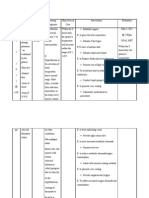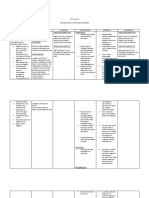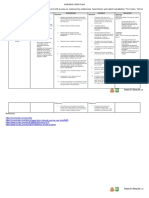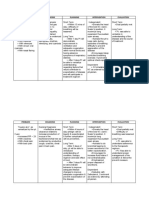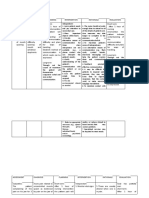NCP Self CaRE Deficit
NCP Self CaRE Deficit
Uploaded by
nicole pageCopyright:
Available Formats
NCP Self CaRE Deficit
NCP Self CaRE Deficit
Uploaded by
nicole pageOriginal Description:
Original Title
Copyright
Available Formats
Share this document
Did you find this document useful?
Is this content inappropriate?
Copyright:
Available Formats
NCP Self CaRE Deficit
NCP Self CaRE Deficit
Uploaded by
nicole pageCopyright:
Available Formats
Assessment
Diagnosis
Analysis
Subjective:
Patient complains
of nearly constant
swelling, stiffness,
and pain, with
occasional
numbness and
tingling in her
hands, wrists, and
elbows
Patient reported
her pain using a
visual analog scale
(VAS) as 8/10 and
stated that the
morning pain was
frequently
unbearable, rating it
as 9/10-10/10
Self-care deficits
related to loss of
motion
Rheumatoid
arthritis is a chronic
progressive disease
causing
inflammation in the
joints and
distention of tissues
resulting in painful
deformity and
immobility,
especially in the
fingers, wrists, feet,
and ankles
Objective:
Swelling on
metacarpal
phalangeal joints
and her proximal
interphalangeal
joints bilaterally
Wrists and elbows
were warm, with
mild edema and
tenderness to
palpation
Goals and
Objective
Short-term
After6 hours of
nursing
interventions, the
patient will:
-identify individual
areas of weakness
or needs
-demonstrate
techniques and
lifestyles changes to
meet self-care
needs
Long-Term
After1weekof
nursing
interventions, the
patient will be able
to:
-Perform self-care
activities within
level of own ability
-
Interventions
Independent
1.Assist patient to
identify self-care
activities
2.Develop a plan
based on the
patients
perceptions and
priorities on how to
establish and
achieve goals to
meet self-care
needs
a. Provide
appropriate
assistive devices.
b.Reinforce correct
and safe use of
assistive devices
3.Allow patient
sufficient time to
complete tasks to
fullest extent of
ability
Collaborative
1.Consult with
rehabilitation
specialists like OT
Rationale
1.The ability to
perform self-care
activities is
influenced by
disease activity
2.Assistive device
may enhance selfcare abilities.
Evaluation
Short-term
After6 hours of
nursing
interventions, the
patient was able to:
-identify individual
areas of weakness
or needs
-demonstrate
techniques and
lifestyles changes to
meetself-careneeds
Long-Term
After1weekof
nursing
interventions, the
patient was be able
to:
-Perform self-care
activities within
level of own ability
3.Gives opportunity
for greater senseof
self-confidence .
1.Helpful in
determining
assistive devices.
You might also like
- Idoc - Pub Nursing Care Plan For Seizure NCPDocument2 pagesIdoc - Pub Nursing Care Plan For Seizure NCPACERET, IVAN LAURENTINE G.No ratings yet
- Viii. Nursing Care Plan: Asessment Diagnosis Planning Intervention Rationale EvaluationDocument3 pagesViii. Nursing Care Plan: Asessment Diagnosis Planning Intervention Rationale Evaluationhehehe29No ratings yet
- NCPDocument3 pagesNCPJerome Vergel RubianesNo ratings yet
- This Study Resource Was Shared Via: Nursing Care Plan FormDocument3 pagesThis Study Resource Was Shared Via: Nursing Care Plan FormissaiahnicolleNo ratings yet
- Problem List Assessment Nursing Diagnosis Planning ImplementationDocument1 pageProblem List Assessment Nursing Diagnosis Planning ImplementationJai Go100% (1)
- Healthcare - Nursing Care Plan - Excess Fluid VolumeDocument4 pagesHealthcare - Nursing Care Plan - Excess Fluid VolumeBenjamin CañalitaNo ratings yet
- Impaired Physical Mobility...Document3 pagesImpaired Physical Mobility...Christy BerryNo ratings yet
- Impaired Physical Mobility R/T Neuromuscular ImpairmentDocument3 pagesImpaired Physical Mobility R/T Neuromuscular ImpairmentjisooNo ratings yet
- NCP FormatDocument4 pagesNCP FormatCoreen Kaye TanNo ratings yet
- Impaired Gas Exchange NCPDocument3 pagesImpaired Gas Exchange NCPRomel BaliliNo ratings yet
- NCP 2 MiDocument16 pagesNCP 2 MiWendy EscalanteNo ratings yet
- NCP CPDocument8 pagesNCP CPxacharoweeNo ratings yet
- NCP Proper CholecystectomyDocument2 pagesNCP Proper CholecystectomyGail Lian SantosNo ratings yet
- HYPONATREMIADocument3 pagesHYPONATREMIADienizs Labini TadenaNo ratings yet
- NCP PpwardDocument15 pagesNCP PpwardKarl Vincent Soso100% (1)
- PUCAN, Julienne BSN III-D - NCP - HYPO&HYPERCHLOREMIADocument2 pagesPUCAN, Julienne BSN III-D - NCP - HYPO&HYPERCHLOREMIAJulienne PucanNo ratings yet
- Subjective:: Assessment Diagnosis Planning Implementation Rationale EvaluationDocument2 pagesSubjective:: Assessment Diagnosis Planning Implementation Rationale EvaluationAyra PunzalanNo ratings yet
- Assessment Explanation of The Problem Planning Nursing Intervention Rationale EvaluationDocument2 pagesAssessment Explanation of The Problem Planning Nursing Intervention Rationale EvaluationRodolfo Bong SemaneroNo ratings yet
- Student Nurses' Community: Nursing Care Plan AmputationDocument3 pagesStudent Nurses' Community: Nursing Care Plan AmputationNur faizah bt azmiNo ratings yet
- NCP FinalDocument18 pagesNCP FinalHelen GonzalesNo ratings yet
- Nursing Care PlansDocument4 pagesNursing Care Plansapi-19762967No ratings yet
- NCP On DyspneaDocument5 pagesNCP On DyspneaDizzy BualanNo ratings yet
- Excess Fluid Volume PPT (Case Press)Document10 pagesExcess Fluid Volume PPT (Case Press)Perrilyn PereyNo ratings yet
- NCPDocument6 pagesNCPNik Rose ElNo ratings yet
- NCPDocument14 pagesNCPRaidis Pangilinan0% (1)
- EsophagomyotomyDocument3 pagesEsophagomyotomySamVelascoNo ratings yet
- NCP Impaired ComfortDocument2 pagesNCP Impaired ComfortGia P. de VeyraNo ratings yet
- Impaired Physical MobilityDocument2 pagesImpaired Physical MobilityAbdelhafiz SusmiranNo ratings yet
- Careplan ExampleDocument6 pagesCareplan Exampleonecharminglady100% (1)
- NCP 2 LRDR For PrintDocument2 pagesNCP 2 LRDR For PrintGeorge PandaNo ratings yet
- NCP Impaired Physical MobilityDocument1 pageNCP Impaired Physical MobilityCharmaine SolimanNo ratings yet
- NCP AidsDocument16 pagesNCP AidstferdianingsihNo ratings yet
- NURSING CARE PLAN - Risk For Fluid Volume DeficitDocument2 pagesNURSING CARE PLAN - Risk For Fluid Volume DeficitDaniel Andre S. SomorayNo ratings yet
- Assessment Nursing Diagnosis Planning Implementation Rationale EvaluationDocument1 pageAssessment Nursing Diagnosis Planning Implementation Rationale EvaluationJames PajarilloNo ratings yet
- NCP FinalDocument5 pagesNCP FinalVenus BonglayNo ratings yet
- MGH 8 - Ihd - NCPDocument12 pagesMGH 8 - Ihd - NCPSesinando Niez Quilao Jr.100% (1)
- Imbalnce Nutrition Less Than Body RequirementsDocument3 pagesImbalnce Nutrition Less Than Body RequirementselheezaNo ratings yet
- NCP Acitivity IntoleranceDocument3 pagesNCP Acitivity IntolerancegizelleNo ratings yet
- Nursing Care Plan: Cues Objectives Interventions Rationale EvaluationDocument2 pagesNursing Care Plan: Cues Objectives Interventions Rationale EvaluationJP2001100% (1)
- Compartment Syndrome NCP (PAIN)Document2 pagesCompartment Syndrome NCP (PAIN)eunica16No ratings yet
- NCP - Activity Intolerance & Excess Fluid VolumeDocument2 pagesNCP - Activity Intolerance & Excess Fluid VolumeCindy MariscotesNo ratings yet
- NCPDocument2 pagesNCPShubhangi SarwanNo ratings yet
- NCP BMDocument1 pageNCP BMSourabh MehraNo ratings yet
- NCP DobDocument2 pagesNCP DobPaulo GeneraloNo ratings yet
- Risk For Activity Intolerance NCPDocument2 pagesRisk For Activity Intolerance NCPMike SoySauce LibrojoNo ratings yet
- Acute Pain Related To Effects of Labor and Delivery ProcessDocument3 pagesAcute Pain Related To Effects of Labor and Delivery ProcessrlinaoNo ratings yet
- HypertensionDocument3 pagesHypertensionkarl de guzmanNo ratings yet
- Assessment Diagnosis Rationale Planning Implementation Rationale EvaluationDocument2 pagesAssessment Diagnosis Rationale Planning Implementation Rationale Evaluationkristel_nicole18yahoNo ratings yet
- Nursing Diagnosis: Urinary Retention: NOC Outcomes (Nursing Outcomes Classification)Document4 pagesNursing Diagnosis: Urinary Retention: NOC Outcomes (Nursing Outcomes Classification)rem_No ratings yet
- NCP RheumatoidDocument5 pagesNCP RheumatoidJane Elizabeth Gonzales MacahiaNo ratings yet
- NCP For COPDDocument3 pagesNCP For COPDcy belNo ratings yet
- V. Nursing Intervention 5.2 Actual Patient Care 5.2.1 Nursing Care PlanDocument11 pagesV. Nursing Intervention 5.2 Actual Patient Care 5.2.1 Nursing Care Planjoyrena ochondraNo ratings yet
- Cues Nursing Diagnosis Rationale Goals and Objectives Nursing Intervention Rationale Evaluation SubjectiveDocument4 pagesCues Nursing Diagnosis Rationale Goals and Objectives Nursing Intervention Rationale Evaluation SubjectiveFaye Dianne Damian-BuenafeNo ratings yet
- Drug Study. AbagonDocument4 pagesDrug Study. AbagonMeriam Angelita Robles AlfaroNo ratings yet
- NCPDocument3 pagesNCPNicole_Santos_6836No ratings yet
- Ncp3rdrot DocxsDocument4 pagesNcp3rdrot DocxsMikko Anthony Pingol AlarconNo ratings yet
- Activity IntoleranceDocument3 pagesActivity IntoleranceRaidis PangilinanNo ratings yet
- As Needed.: Environmental Stimuli 6Document4 pagesAs Needed.: Environmental Stimuli 6Nicole GumolonNo ratings yet
- Ventricular Septal Defect, A Simple Guide To The Condition, Treatment And Related ConditionsFrom EverandVentricular Septal Defect, A Simple Guide To The Condition, Treatment And Related ConditionsNo ratings yet
- The Ride of Your Life: What I Learned about God, Love, and Adventure by Teaching My Son to Ride a BikeFrom EverandThe Ride of Your Life: What I Learned about God, Love, and Adventure by Teaching My Son to Ride a BikeRating: 4.5 out of 5 stars4.5/5 (2)











